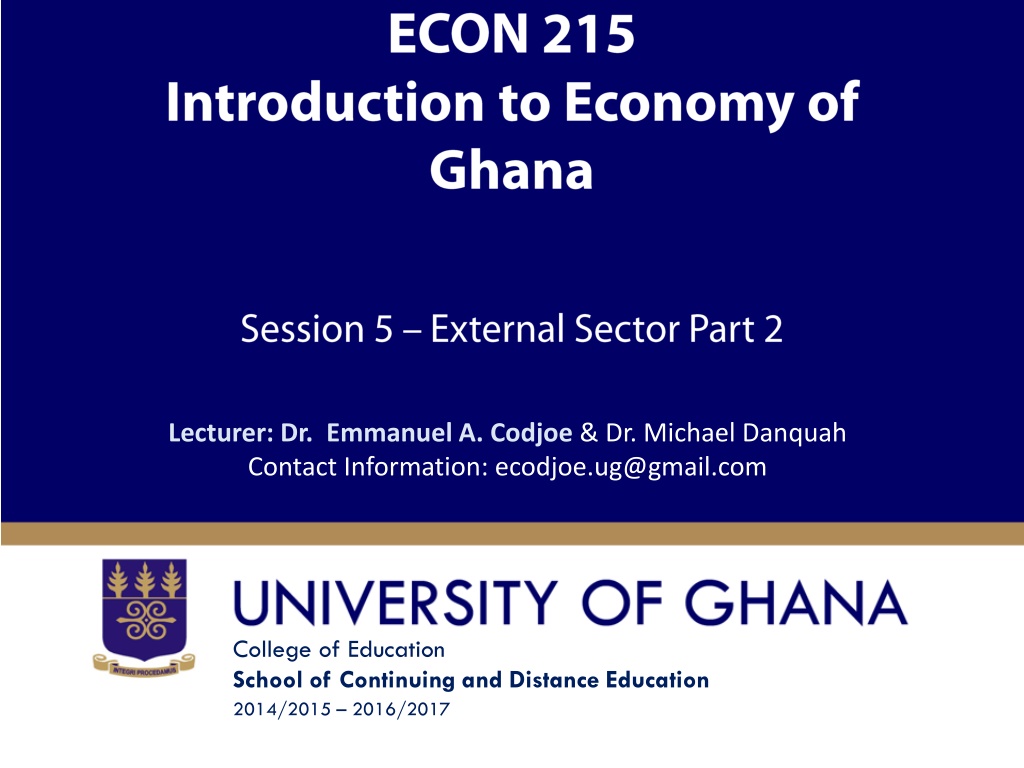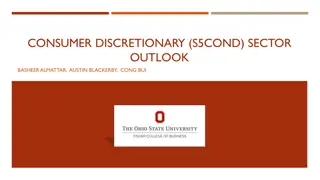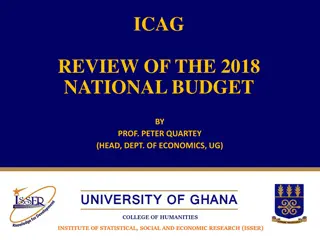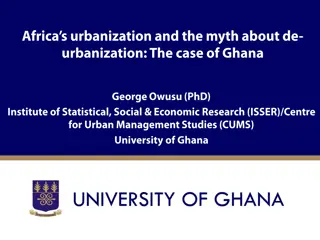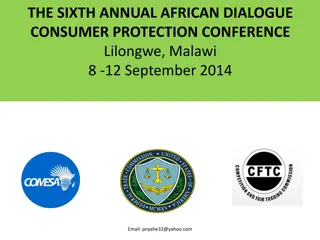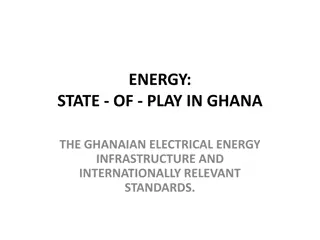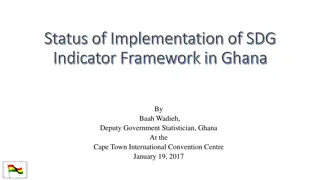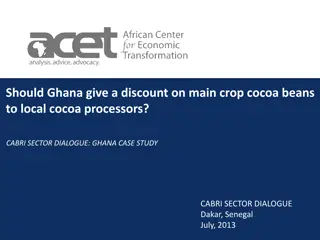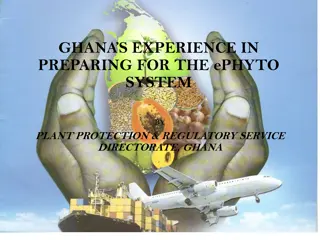Ghana's External Sector: Strategies and Outlook
This session led by Dr. Emmanuel A. Codjoe and Dr. Michael Danquah delves into Ghana's external sector, discussing its importance, trade direction, and strategies for development. Students will gain insights into Ghana's trade dynamics, balance of payments, and future outlook. The session covers key topics like Ghana's trade partners, exports destinations, and the benefits of international trade. Reading materials will be provided through Sakai to supplement learning.
Download Presentation

Please find below an Image/Link to download the presentation.
The content on the website is provided AS IS for your information and personal use only. It may not be sold, licensed, or shared on other websites without obtaining consent from the author.If you encounter any issues during the download, it is possible that the publisher has removed the file from their server.
You are allowed to download the files provided on this website for personal or commercial use, subject to the condition that they are used lawfully. All files are the property of their respective owners.
The content on the website is provided AS IS for your information and personal use only. It may not be sold, licensed, or shared on other websites without obtaining consent from the author.
E N D
Presentation Transcript
Lecturer: Dr. Emmanuel A. Codjoe & Dr. Michael Danquah Contact Information: ecodjoe.ug@gmail.com College of Education School of Continuing and Distance Education 2014/2015 2016/2017
Session Overview Session Overview: This session considers Ghana s external sector in detail and discuss the medium term strategies for Ghana s external sector. Goals/ Objectives: At the end of the session, the student will Understand the importance of Ghana s external sector Know the direction of Ghana s trade Be aware of strategies which have been put in place to enhance the development of Ghana s external sector. Slide 2
Session Outline The key topics to be covered in the session are as follows: Topic One: Ghana s External Sector Topic Two: Ghana s Balance of Payments Topic Three: Outlook For the External Sector Slide 3
Reading List Refer students to relevant text/chapter or reading materials you will make available on Sakai Slide 4
Topic One GHANA S EXTERNAL SECTOR Slide 5
Importance of External Sector Like all countries Ghana trades with the rest of the world because of the benefits derived from trade. These benefits include the following: a. It enables Ghana to access goods and services not available locally. b. Ghana is able to sell goods and services that it has in relative abundance. c. Ghana is able to attract foreign expertise and capital to develop her economy. d. Trade increases competition which forces firms to be more efficient and offer more benefits to consumers. e. Because of the need to produce for export, Ghana is able to take advantage of benefits derived from large-scale production i.e. economies of scale. Slide 6
Direction of Ghanas Trade During the review period, the European Union received the largest share of Ghana s total exports (29.1%). The other recipients were the Far East (26.5%), Other European countries (13.3%), Other Economies (9.9%), the Rest of Africa (9.5%), ECOWAS (8.6%), and North America (3.0%). Destination of Exports India was the single largest destination of Ghana s exports in the first quarter of 2015, representing about 12.4 per cent. The main export to India was gold. Other important markets for Ghanaian exports included: Switzerland (10.9%), Netherlands (8.7%), South Africa (8.6%), United Arab Emirates (8.0%), China (7.0%), Italy (6.6%), Malaysia (3.3%), Portugal (3.2%) and USA (2.8%). Slide 7
Direction of Ghanas Trade Contd Origin of Imports In terms of geographical distribution, the Far East was the leading source of imports accounting for 30.6 per cent of the total non-oil imports. The European Union followed with a share of 27.5 per cent, North America (12.6%), Other (11.1%), ECOWAS (7.8%), Rest of Africa (5.5%) and Other Europe (4.9%). China was the leading source of Ghana s imports with a share of 15.3 per cent. Other major sources of imports were United States (9.7%), Netherlands (6.5%), Belgium (4.8%), India (4.0%), South Africa (3.3%), Cote d Ivoire (3.2%), Canada (2.8%), Malta (2.8%) and United Kingdom (2.7%). Slide 8
Top Ten Major Non-Oil Imports Jan - Mar 2014 Jan - Mar 2015 Description US$ M (fob) 115.57 78.99 36.57 137.45 57.01 42.16 38.28 276.43 128.19 61.11 52.68 34.46 200.50 200.50 % Distr. Description US$ M (fob) 144.26 88.79 55.47 259.49 118.89 76.31 64.29 270.48 82.63 67.16 60.91 59.78 133.81 133.81 % Distr. 17.9 11.0 6.9 32.1 14.7 9.4 8.0 33.5 10.2 8.3 7.5 7.4 16.6 16.6 Capital Motor vehicles for the transport of goods, n.e.s. Machines for the reception,conversion and transmission of etc Consumption Frozen Fish Rice Sugar Intermediate Palm oil and its fractions Cement clinkers Wheat and meslin Polyethylene Other Motor vehicles for the transport of persons 15.8 10.8 5.0 18.8 7.8 5.8 5.2 37.9 17.6 8.4 7.2 4.7 27.5 27.5 Capital Floating or submersible drilling or production platforms Motor vehicles for the transport of goods Consumption Rice Insecticides, herbicides and fungicides Frozen fish Intermediate Semi-manufactured gold Cement and clinker Palm oil and its fractions Wheat and meslin Other Motor vehicles for the transport of persons Grand Total Grand Total 729.94 100.0 808.04 100.0 Slide 9
Top Ten Major Non-Traditional Export Items Jan - Mar 2014 Jan - Mar 2015 Description US$ M % Distr. Description US$ M % Distr. Palm kernel or babassu oil (excl. crude) fractions 34.72 17.6 Palm oil and its fractions 36.19 15.9 Prepared or preserved tuna, skipjack and atlantic bonito 31.83 16.1 Prepared or preserved tuna 35.88 15.8 Palm oil and its fractions 27.61 14.0 Cashew nuts 35.04 15.4 Cashew nuts 17.92 9.1 Pebbles, gravels, broken or crushed stone etc for road 20.71 9.1 17.15 8.7 Shea (karite) oil and fractions 19.60 8.6 Tableware, kitchenware, other household articles and toilet articles Sesamum seeds 16.76 8.5 Plywood and veneered panels 18.90 8.3 Superphosphates 15.20 7.7 Aluminium 16.66 7.3 Aluminium, unwrought, not alloyed 14.31 7.3 Tableware, kitchenware, other household articles 15.51 6.8 Technically specified natural rubber 11.60 5.9 Medium oils, kerosine type jet fuel 14.38 6.3 Fruit, fresh - other, nes 10.09 5.1 Sesamum seeds 14.13 6.2 197.19 100.0 227.02 100.0 Slide 10
Topic Two GHANA S BALANCE OF PAYMENTS Slide 11
Snapshot of Ghanas Balance of Payments (BoP) External Sector Developments The overall balance of payments improved significantly to a deficit of US$85.2 million in 2014 from a deficit of US$874.2 million in 2013. The outturn in 2014 was the result of an improvement in the current account which outweighed the deterioration in the capital and financial account. Current Account The current account balance improved to a deficit of US$3,698.2 million (9.2% of GDP) from a deficit of US$5,704.1 million (11.9% of GDP) in 2013. This development was the net result of significant reduction in the trade deficit, improvement in the current transfers account and worsening of the services and investment income accounts. Slide 12
Snapshot of Ghanas Balance of Payments (BoP) Cont d Trade Balance The trade balance recorded a lower deficit of US$1,386.9 million compared with a deficit of US$3,848.3 million in 2013. This was the net result of a sharp slowdown in imports and a moderate reduction in export revenues in 2014. Merchandise Exports The value of merchandise exports for the review year was estimated at US$13,213.1 million, indicating a decrease of 3.9 per cent from the outturn of 2013. Higher receipts from the export of timber, cocoa beans and cocoa products were not enough to offset the reductions in receipts from gold, crude oil and other non-traditional exports. Falling commodity prices on the international market for gold and oil mainly accounted for the decline in earnings. Slide 14
Snapshot of Ghanas Balance of Payments (BoP) Cont d Merchandise Imports The value of merchandise imports for 2014 was estimated at US$14,600.1 million, down by 17 per cent from the outturn in 2013. The decline in imports was the result of a significant reduction in non-oil imports underpinned by the sharp depreciation of the domestic currency in the review year. However, imports of crude oil and refined oil products increased marginally. Oil Imports The value of oil imports (including gas) rose by 4 per cent to US$3,694.0 million in 2014, driven by increased imports of finished oil products. Slide 15
Snapshot of Ghanas Balance of Payments (BoP) Cont d Total expenditure on non-oil imports in 2014 declined by 22.4 per cent to US$10,906.1 million. The decrease was reflected in all categories of imports, namely capital, intermediate and consumption goods. Non-Oil Imports The services, income and transfers account recorded a deficit of US$2,311.3 million, compared with a deficit of US$1,855.7 million in 2013. There were increases in the net outflows in the services and income accounts in the review year. However, there was an improvement in the net inflow in the net current (official and private) transfers account. The Services and Income accounts registered net outflows of US$2,602.3 million and US$1,717.4 million respectively. The current transfers (net) registered an increase of 3.6 percent to US$2,008.5 million. This development was the net result of a 7.5 per cent increase in private remittances (net) to US$1,998.9 million and 88 per cent decline in official transfers to US$9.6 million in the review year. Services, Income and Current Transfers Slide 16
Snapshot of Ghanas Balance of Payments (BoP) Cont d The capital and financial account registered a net inflow of US$3,752.8 million, representing a decline of 30.1 per cent from the outturn in 2013. The capital account did not record any inflow in 2014. Capital and Financial Account Transactions in the financial account resulted in a net inflow of US$3,752.8 million compared with US$5,018.9 million registered in 2013. The year witnessed increases of US$130.7 million in foreign direct investment and US$177.0 million in net portfolio investments to US$3,357.0 million and US$835.9 million respectively. Official capital inflows however registered a decrease of US$508.0 million to US$941.0 million. This was the net result of decreases of US$388.1 million and US$120.0 million in loans and amortization respectively, and an increase of US$235.6 million in Government oil investments. Financial Account Slide 17
Snapshot of Ghanas Balance of Payments (BoP) Cont d International Reserves The stock of net international reserves (NIR)declined by US$85.2 million to US$3,199.3million at the end of 2014. Gross international reserves recorded a draw down of US$171.14 million to US$5,461.0 million at the end of 2014, sufficient to provide cover for 3.2 months imports of goods and services compared with 3.1 months in 2013 Slide 18
Topic Three OUTLOOK FOR THE EXTERNAL SECTOR Slide 19
Medium Term External Sector Policies The medium-term objective of the external sector policy under this policy framework (i.e. the Ghana Shared Growth and Development Agenda II (GSGDA II) is to review and intensify the efforts at improving Ghana s export competitiveness; diversifying and increasing exports and markets; accelerating economic integration with other regional and/or sub-regional states; as well as building gross international reserves adequate to cushion the economy against external shocks. Accordingly, the efforts to substantially increase merchandise exports and reverse the persistently high trade deficits will be accelerated, whilst implementing a long-term strategy to progressively increase Ghana s gross international reserve to at least six months of imports cover, consistent with the requirements of the West Africa Monetary Zone (WAMZ) convergence criterion. Slide 20
Medium Term External Sector Strategies Improve competitiveness and increase exports, thestrategies to be implemented include: ensuring competitive real exchange rates that support the export sector; improving the supply side capacity of import/export policy regime; and strengthening the links between industrial and trade policies. Trade Competitiveness: To improve trade Diversify and Increase Exports: The strategies to be implemented to ensure diversification and increase in Ghana s exports include: promoting the production of non-traditional export products; taking full advantage of Preferential Access to markets; strengthening participation of Ghana in Multilateral Trade negotiations; and ensuring effective implementation of the ETLS with member countries. Slide 21
Medium Term External Sector Strategies Cont d Accelerate economic integration with other regional and sub- regional blocks and markets: To take advantage of the significant economic opportunities that exist in the West Africa sub-region and other regional blocks for accelerated development of the country, the following strategies will be implemented: i. ii. iii. iv. accelerate the implementation of the WAMZ programme; implement the ECOWAS Community Development Programme; ensure that National Trade Policy reflects ECOWAS protocols; and strengthen trade relations with other regional blocks and markets. Slide 22
Medium Term External Sector Strategies Cont d Expanding Access to Domestic and International Markets: i. Government will implement the National Export Strategy, particularly, the diversification of export commodities and markets; ii. complete the implementation of the National Trade Policy; apply World Trade Organization (WTO) arrangements and explore other bilateral and multilateral protocols for the promotion of domestic industries; and iii. intensify business outsourcing and sub-contracting.
References Slide 24
